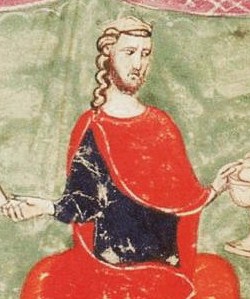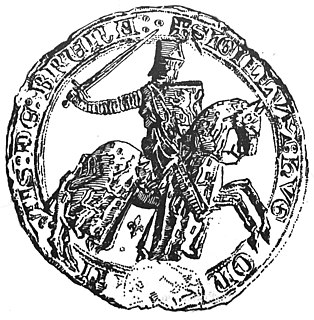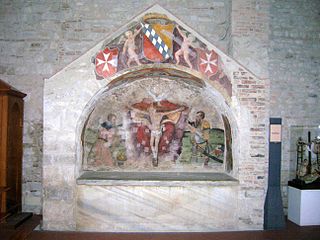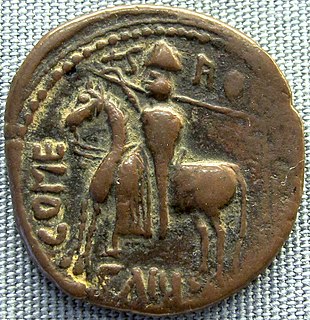
Peter III of Aragon, known as Peter the Great, was King of Aragon, King of Valencia, and Count of Barcelona from 1276 to his death; this union of kingdoms was called the Crown of Aragon. At the invitation of some rebels, he conquered the Kingdom of Sicily and became King of Sicily in 1282, pressing the claim of his wife, Constance, uniting the kingdom to the crown. He was one of the greatest of medieval Aragonese monarchs.

Roger II was King of Sicily, son of Roger I of Sicily and successor to his brother Simon. He began his rule as Count of Sicily in 1105, became Duke of Apulia and Calabria in 1127, and then King of Sicily in 1130. By the time of his death at the age of 58, Roger had succeeded in uniting all the Norman conquests in Italy into one kingdom with a strong centralized government.

Frederick II was the regent and subsequent King of Sicily from 1295 until his death. He was the third son of Peter III of Aragon and served in the War of the Sicilian Vespers on behalf of his father and brothers, Alfonso ΙΙΙ and James ΙΙ. He was confirmed as King of Trinacria by the Peace of Caltabellotta in 1302. His reign saw important constitutional reforms: the Constitutiones regales, Capitula alia, and Ordinationes generales.

Tancred was King of Sicily from 1189 to 1194. He was born in Lecce an illegitimate son of Roger III, Duke of Apulia by his mistress Emma, a daughter of Achard II, Count of Lecce. He inherited the title "Count of Lecce" from his grandfather and is consequently often referred to as Tancred of Lecce. Due to his short stature and unhandsome visage, he was mocked by his critics as "The Monkey King".

William I, called the Bad or the Wicked (Sicilian: Gugghiermu lu Malu, was the second King of Sicily, ruling from his father's death in 1154 to his own in 1166. He was the fourth son of Roger II and Elvira of Castile.

Roger III, of the House of Hauteville, was the eldest son and heir of King Tancred of Sicily and Queen Sibylla. He was made Duke of Apulia, probably in 1189, shortly after his father's accession. In the summer of 1192 he was crowned co-king with his father. Follari were minted at Messina bearing both Tancred and Roger's names as kings.

Robert I of Burgundy, known as Robert the Old and "Tête-Hardi", was Duke of Burgundy from 1032 to his death. Robert was son of King Robert II of France and brother of Henry I of France.

Roger Borsa was the Norman Duke of Apulia and Calabria and effective ruler of southern Italy from 1085 until his death. He was the son of Robert Guiscard, the conqueror of southern Italy and Sicily; Roger was not as adept as his father, and most of his reign was spent in feudal anarchy.

Hugh, Count of Brienne and Lecce was the second surviving son of Count Walter IV of Brienne and Marie de Lusignan of Cyprus.
The Principality of Taranto was a state in southern Italy created in 1088 for Bohemond I, eldest son of Robert Guiscard, as part of the peace between him and his younger brother Roger Borsa after a dispute over the succession to the Duchy of Apulia.
Simon of Hauteville, called Simon de Hauteville in French and Simone D'Altavilla in Italian, was the eldest son and successor of Roger the Great Count, count of Sicily, and Adelaide del Vasto, under whose regency he reigned.
Serlo I of Hauteville was a son of Tancred of Hauteville by his first wife, Muriella, probably the youngest, though some sources call him the eldest. Born before 1010, he was the eldest son of Tancred's to remain in Normandy. After a dispute with a neighbour, whom he killed over an insult, Serlo was exiled for three years. Around 1041, his father died and he inherited the small fief of Hauteville in the Cotentin and the sirery of Pirou through his wife. He was regarded, as were his brothers, as an exceptional warrior.

Jordan I, count of Aversa and prince of Capua from 1078 to his death, was the eldest son and successor of Prince Richard I of Capua and Fressenda, a daughter of Tancred of Hauteville and his second wife, also named Fressenda, and the nephew of Robert Guiscard, duke of Apulia, Calabria, and Sicily. He, according to William of Apulia, "equalled in his virtues both the duke and his father."
Jordan of Hauteville was the eldest son and bastard of Roger I of Sicily. A fighter, he took part, from an early age, in the conquests of his father in Sicily.

Abelard of Hauteville was the eldest son of Humphrey, count of Apulia and Calabria (1051–1057), and his Lombard wife, Gaitelgrima of Salerno, also known as Altrude. He was supposed to inherit his father's lands, but Robert Guiscard, his uncle and guardian, who was elected count on Humphrey's death, confiscated them.

Roger III was the eldest son of King Roger II of Sicily and Elvira of Castile. He was the Duke of Apulia from 1134 until his death.
Roger IV (1152–1161) was the eldest son of William I of Sicily and Margaret of Navarre. Twice in his short life he was the object of the barons' intent to replace his father as king. When he was made the duke of Apulia is unknown, probably after his father's assumption of power in 1154.
Geoffrey or Godfrey was the second eldest son of Roger I of Sicily. He was probably a bastard, like his elder brother Jordan, but he may have been a legitimate son by either Judith of Évreux or Eremburga of Mortain. Either way, he stood no chance of inheriting, for he had leprosy, or some similar disease. He never married, but was engaged to a daughter of Boniface del Vasto.

The County of Apulia and Calabria, later the Duchy of Apulia and Calabria, was a Norman country founded by William of Hauteville in 1042 in the territories of Gargano, Capitanata, Apulia, Vulture, and most of Campania. It became a duchy when Robert Guiscard was raised to the rank of duke by Pope Nicholas II in 1059.















